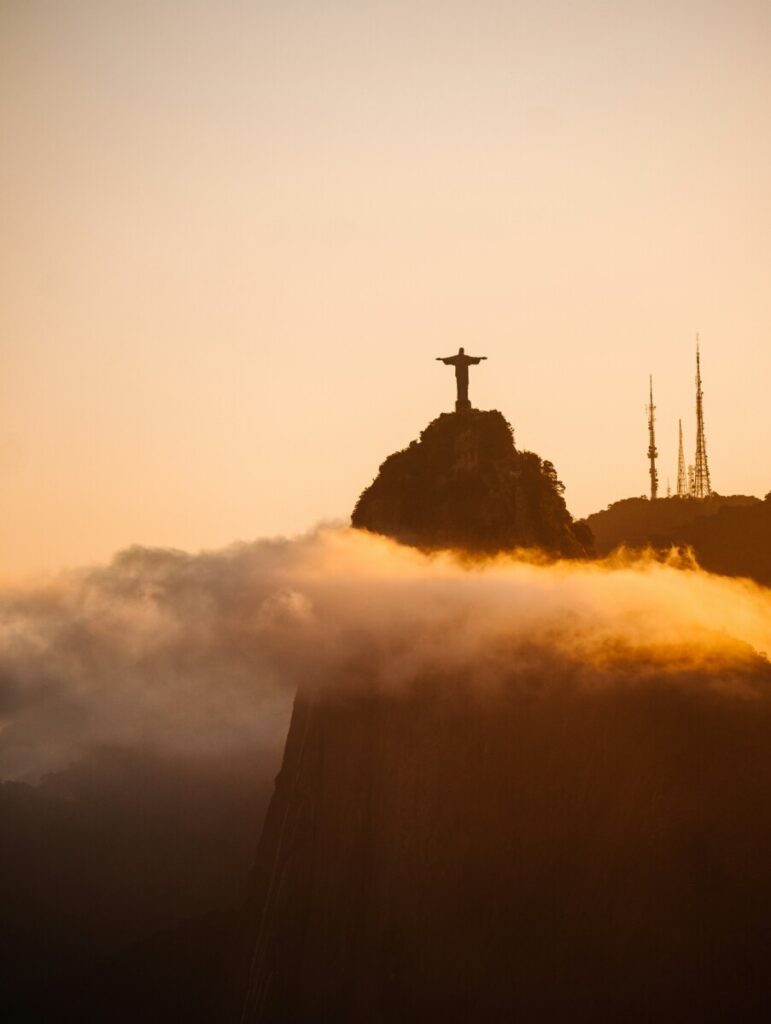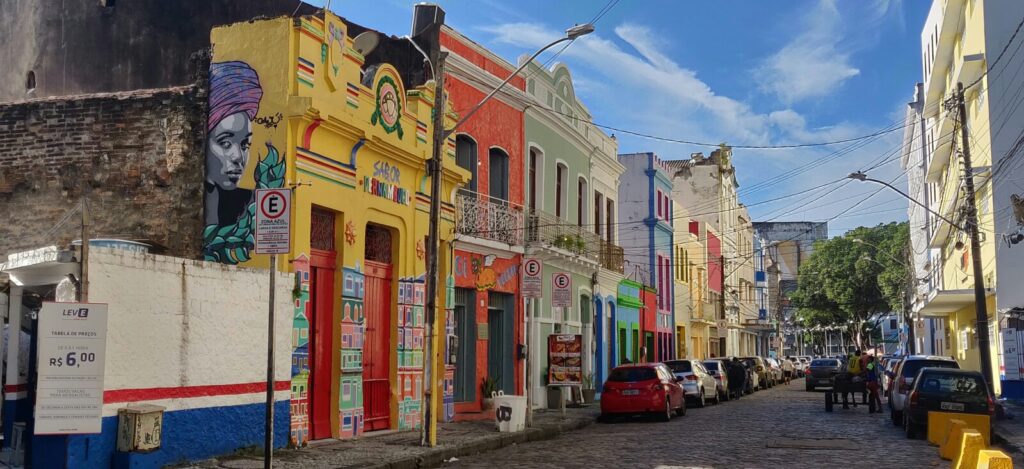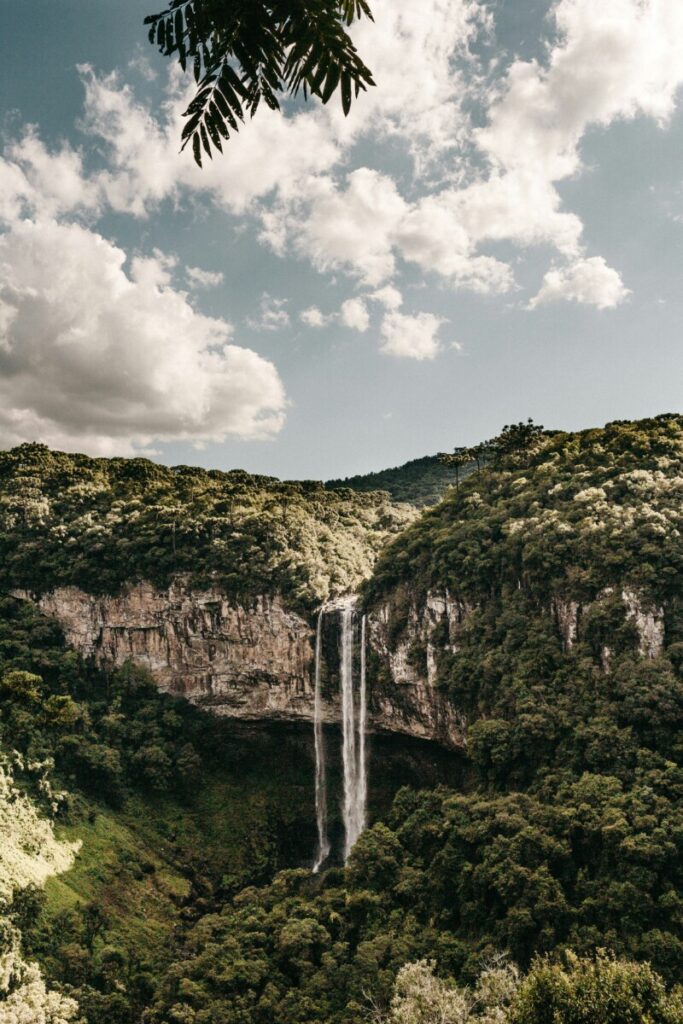Brazil is one of the largest countries in the world and the biggest in South America. This makes it incredibly diverse in terms of culture, ethnicity, and geography, ranging from the Amazon rainforest to paradise-like beaches and vast rivers.
It is also one of the most populous countries in the world. Its culture is a vibrant blend of indigenous, African, European, and Asian influences, reflected in its music, dance, cuisine, and festivals.
That’s why today we want to share a list of must-see places in case you choose it as your destination for a volunteer experience.

RIO DE JANEIRO
Rio de Janeiro is a city located in southeastern Brazil, famous for its stunning beaches, lively culture, and iconic landmarks.
Its main tourist attractions include:
- Christ the Redeemer: One of the New Seven Wonders of the World, this massive statue of Jesus Christ sits atop Corcovado Mountain, offering a breathtaking view of the city. You can find a dedicated blog post about this monument and its fascinating details.
- Sugarloaf Mountain (Pão de Açúcar): An impressive granite monolith that provides panoramic views of the city and Guanabara Bay.
- Copacabana and Ipanema Beaches: Two of the most famous beaches in the world, known for their vibrant atmosphere and natural beauty.
- Carnival: Rio’s Carnival is one of the biggest and most colorful in the world, featuring parades, samba, and spectacular costumes. If your trip coincides with this event, you’ll experience something truly unforgettable.
- Lapa and the Selarón Steps: A historic neighborhood famous for the colorful tiled staircase designed by artist Jorge Selarón.Rio is also well known for its passion for football, nightlife, and rich Brazilian traditions.
Rio is also well known for its passion for football, nightlife, and rich Brazilian traditions.
AMAZONAS
The state of Amazonas is one of the most fascinating and remote regions of Brazil, known for its vast territory, incredible jungles, and rich biodiversity. It is located in northern Brazil and is home to the Amazon Rainforest, the largest tropical rainforest in the world.
Some must-visit places include:
- Amazon Rainforest: The largest tropical rainforest on Earth, covering much of the state and playing a vital role in global climate balance. It is home to an incredible variety of flora and fauna, including many endemic species found nowhere else.
- Amazon River: The longest and most voluminous river in the world, crossing the state and serving as a crucial transportation route for local communities. The Amazon has thousands of tributaries forming an impressive water network.
- Manaus (Capital): The largest city and capital of the Amazonas state. Known for its colonial architecture, the Amazon Theatre, and its importance as an economic, cultural, and tourist hub. Manaus is located in the heart of the rainforest, making it a major gateway for exploration.
- Amazon Biosphere Reserve: A UNESCO-protected area that includes national parks and indigenous reserves. It plays a crucial role in species conservation and the fight against deforestation.
Amazonas is home to numerous indigenous communities that can be visited through excursions, many of which have preserved their traditions and way of life for centuries.
The state is also famous for its eco-tourism activities, such as Amazon River cruises, jungle hikes, and wildlife watching, including pink river dolphins, jaguars, and exotic birds.
SALVADOR DE BAHIA
Salvador is one of the most emblematic and culturally rich cities in Brazil, known for its deep history, Afro-Brazilian traditions, and vibrant street life. Located in the northeast of the country, Salvador was Brazil’s first capital and remains an important cultural and tourist center.
Some must-visit attractions include:
- Pelourinho: The historic center of Salvador, a UNESCO World Heritage Site. With its cobblestone streets, colorful colonial houses, and lively squares, Pelourinho is the cultural heart of the city. It is full of history, featuring baroque churches like the Church of São Francisco and the Bahian Museum.
- Church of Bonfim: A religious icon in Salvador, the Church of Bonfim is an important pilgrimage site where visitors tie colorful ribbons on the gates as part of a tradition to make wishes and promises.
- Beaches: Salvador boasts incredible beaches along its coastline, such as Porto da Barra, Praia do Flamengo, and Praia de Itapuã. These beaches are perfect for sunbathing, water sports, or simply relaxing by the sea.
- Lacerda Elevator & Mercado Modelo: The Lacerda Elevator connects the Lower City (Cidade Baixa) with the Upper City (Cidade Alta) and is one of Salvador’s most iconic landmarks. Nearby is the Mercado Modelo, where visitors can shop for handicrafts, souvenirs, and local products.
- Afro-Brazilian Culture: Salvador is the epicenter of Afro-Brazilian culture, with strong African influences in its music, dance, religion, and cuisine. Candomblé, an Afro-Brazilian religion, has a strong presence in the city, and events like the Yemanjá Festival and Salvador’s Carnival are highly significant.
- Salvador’s Carnival: This is one of the biggest and most energetic carnivals in the world, famous for its street parades (blocos) and electric trios (trucks with live music). The sounds of samba, axé, and other tropical rhythms fill the streets, turning the city into a massive party.
Salvador has a unique energy, blending history, religion, music, food, and nature. It is a city that invites exploration, whether for its cultural heritage or its festive spirit.

IGUAÇU
The Iguazu Falls are one of the most breathtaking natural destinations in South America and the world, located on the border between Brazil and Argentina. This massive waterfall system stretches over 2,700 meters and is surrounded by dense tropical rainforest, making it a true natural wonder.
The national park where the falls are located spans two countries: Iguazú National Park in Argentina and Iguaçu National Park in Brazil. Both areas offer spectacular views, each with a unique perspective of the falls.
The waterfall system consists of approximately 275 cascades, with the tallest, the Devil’s Throat (Garganta do Diabo), reaching a height of 80 meters. This particular waterfall is especially impressive, as the roaring water and mist create an immersive experience. On the Brazilian side, trails allow visitors to walk along a series of platforms that provide panoramic views of the falls. A short trail leads to an incredible front-facing view of the Devil’s Throat. Visitors can also take the Ecological Train within the park to explore different sections.
The region is home to an incredible variety of wildlife, including toucans, monkeys, jaguars, caimans, and a vast array of butterflies and tropical birds. The surrounding jungle, part of the Atlantic Forest, is a rich and diverse ecosystem.
Tourists can enjoy activities such as boat rides to get closer to the falls, jungle treks, visits to the Itaipu Dam (one of the largest hydroelectric dams in the world, located near the falls), and ecotourism experiences.
SÃO PAULO
São Paulo is Brazil’s largest city, blending modernity, culture, and diversity—a perfect destination for those seeking art, gastronomy, and nightlife.
Some must-visit places in the city include:
- Avenida Paulista: The financial and cultural heart of the city. Here, you’ll find MASP (São Paulo Museum of Art), home to an impressive art collection. It’s a great place for a walk, enjoying street performers, cafés, and bookstores.
- Ibirapuera Park: The most famous park in São Paulo, ideal for relaxing, exercising, and visiting museums. Highlights include the Afro Brazil Museum, MAM (Museum of Modern Art), and the Biennial Pavilion.
- Historic Downtown: Visit the Catedral da Sé, Altino Arantes Building (one of the city’s best viewpoints), and Pátio do Colégio (the historical site where São Paulo was founded).
- Municipal Market (Mercadão): Famous for the mortadella sandwich and exotic fruits. The market’s architecture is stunning, featuring colorful stained-glass windows and a lively atmosphere.
- Beco do Batman (Vila Madalena): A vibrant alley filled with street art and graffiti. Perfect for taking photos and exploring the bars and cafés in the area.
- Pinacoteca do Estado: One of Brazil’s most important art museums, housed in a historic building with beautiful outdoor gardens.
- Liberdade District: The largest Japanese neighborhood outside Japan, full of sushi restaurants, anime shops, and Asian markets.
- Rua Oscar Freire: São Paulo’s most luxurious shopping street, lined with high-end boutiques and chic cafés.
- Morumbi Stadium or Allianz Parque: A great experience for football fans, visiting one of these famous stadiums.
- Edifício Itália Viewpoint: One of the best viewpoints in São Paulo, offering panoramic views of the city. The top floor houses the Terraço Itália restaurant, perfect for a special dinner.
PANTANAL
The Pantanal is one of Brazil’s most incredible regions and the largest wetland in the world. It is an ideal destination for nature lovers and wildlife enthusiasts, with unmatched biodiversity and breathtaking landscapes.
It spans across Brazil, Bolivia, and Paraguay, though most of it is located in the Brazilian states of Mato Grosso and Mato Grosso do Sul.
This vast ecosystem is one of the world’s most important nature reserves, with an extraordinary concentration of wildlife, especially during the dry season. Unlike the Amazon, the Pantanal has more open vegetation, making it much easier to spot animals. Some of the species you can see include:
- Jaguars (one of the best places in the world to see them)
- Capybaras and caimans
- Toucans, macaws, and exotic birds
- Anacondas and giant otters
The best time to visit is during the dry season (May to October), as wildlife spotting is much easier.
Some of the activities available in the Pantanal include:
- Jeep or boat safaris
- Horseback riding
- Piranha fishing (usually “catch and release”)
- Birdwatching
- Eco-hiking
The main gateways to the Pantanal are Cuiabá (Mato Grosso) and Campo Grande (Mato Grosso do Sul). From there, visitors can travel to Poconé or Corumbá, the main base cities for exploring the region.
The Pantanal is a less touristy but spectacular destination, offering easier wildlife sightings than the Amazon and an incredible array of ecosystems to explore.

There are many more amazing destinations to visit in this vast and diverse country, such as Recife and Olinda, Fernando de Noronha, or Fortaleza and Jericoacoara (which we also highly recommend).
We also encourage you to try Brazilian cuisine and, if your travel dates align, experience some of the country’s famous festivals.




